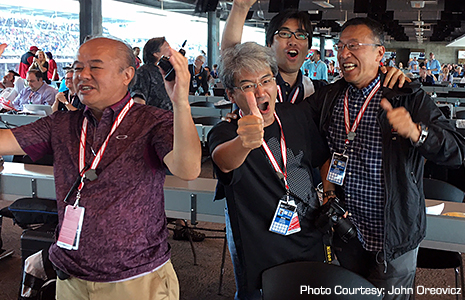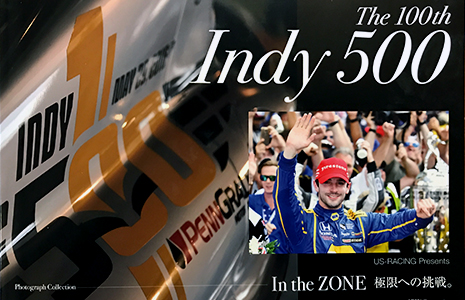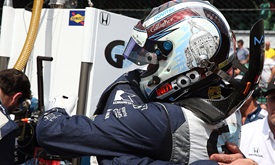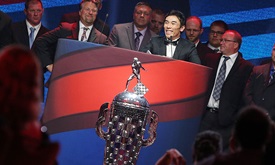This was one time when cheering in press box was allowed
MAY 30, 2017
INDIANAPOLIS – Once upon a time, when reaction in Indianapolis Motor Speedway’s media center to what was happening on track became overly exuberant, the legendary Bill York would take to the microphone to remind us we were in a working press room.
In other words, be professional. Keep it down. And don’t break the cardinal rule of sportswriting and cheer in the press box.
Some of us still grumble when the Indianapolis 500 ends with applause from those who are supposed to be objective observers. But when it happened Sunday as Takuma Sato crossed the finish line in front of Helio Castroneves, some of us old grumblers smiled.
 Yes, our friends from Japan cheered in the press box Sunday, and we liked it. We understood what went into it and what was behind it. We got it, and we approved.
Yes, our friends from Japan cheered in the press box Sunday, and we liked it. We understood what went into it and what was behind it. We got it, and we approved.
For years, writers and broadcasters from Japan have followed the exploits and accomplishments of their nation’s drivers in the Verizon IndyCar Series. We’ve seen them in Pocono and Texas, in Watkins Glen and Phoenix. We’ve seen them weary from travel and time changes, and we’ve seen them work on their home turf.
But this was the first time we’ve seen one of their drivers win the Indianapolis 500 presented by PennGrade Motor Oil. They enjoyed it, and they had every right to.
To understand their joy about and the magnitude of Sato’s victory, imagine what they’ve been through. Imagine America is a country the size of California. It has a rich automotive tradition, builds cars and motorcycles sold the world over, and thus has a deep and storied history in motorsports.
Imagine you’re a sportswriter, and your assignment is to follow the drivers from your country who have reached the highest levels of racing worldwide and corroborate their accomplishments. These racers are national heroes, revered by your readers. You travel the world, only return home occasionally, and doggedly pursue your subjects.
Only one problem. Your subjects haven’t been wildly successful on the world stage. Sure, they’ve made it to Formula One. They’ve become regular figures in INDYCAR. But they aren’t known for championships or major victories. Other countries churn out first-rate professional drivers at greater frequency and success. Your racers are competent and qualified, but they aren’t dominating the sport the way those from other countries are.
Your readers follow every word you write, devour every piece of information they can find. Every photograph is inspected, every box score dissected. Then, one Sunday in May when few are expecting it to happen, your racer wins the biggest race in the world.
What do you do? Well, you might just celebrate. And you’d be justified.
That’s what we saw when Sato won. We heard Japanese broadcasters losing it while trying to narrate the final lap (watch the Gaora Sports live broadcast below). We saw writers and photographers hugging each other. We saw grown men trying not to weep.
American journalists were reminded of trips to Twin Ring Motegi and wished INDYCAR still raced there. We recalled the hundreds of fans who stood patiently in line at autograph sessions, each with a handmade gift for the racer whose autograph they sought.
 We thought of journalists like Kazuki and Hiroyuki Saito, who have followed a long list of Japanese drivers through North American open-wheel racing since the 1990s. They’ve written about and photographed Shigeaki Hattori, Kosuke Matsuura, Tora Takagi, Hideki Mutoh and Hideshi Matsuda, among many others. Before Sunday, though, they had never documented one of their countrymen winning the Indy 500
We thought of journalists like Kazuki and Hiroyuki Saito, who have followed a long list of Japanese drivers through North American open-wheel racing since the 1990s. They’ve written about and photographed Shigeaki Hattori, Kosuke Matsuura, Tora Takagi, Hideki Mutoh and Hideshi Matsuda, among many others. Before Sunday, though, they had never documented one of their countrymen winning the Indy 500
The Saito brothers recently released another book about the 2016 Indy 500, filled with great photos and with words from veteran American sportswriter John Oreovicz. They’re donating a portion of the proceeds from the $35 book to help ongoing recovery efforts from the earthquake and tsunami of 2011 (send an email to webmaster@us-racing.net for information to purchase the book). The Japan recovery efforts are also Sato’s primary charitable cause.
As our colleagues celebrated, "Oreo" took photos. Any other celebration in a media center would’ve drawn scorn. But this was fun. This had a reason. This had what any journalist wants – a story.
Old sportswriters can be crusty at times. We complain about people who get too rah-rah in their coverage. We scoff at millennials and their crazy social media. We wish the suits hadn’t wrecked newspapers. We are set in our ways and one of those ways is clear: We don’t cheer in the press box.
But on Sunday, we smiled with those who did. They earned the right.
The final turn of the #Indy500 for champion @TakumaSatoRacer was exciting in English, wait until you hear the @gaora_motor broadcast... pic.twitter.com/azrMGwSV9Z
— IndyCar Series (@IndyCar) May 29, 2017




















